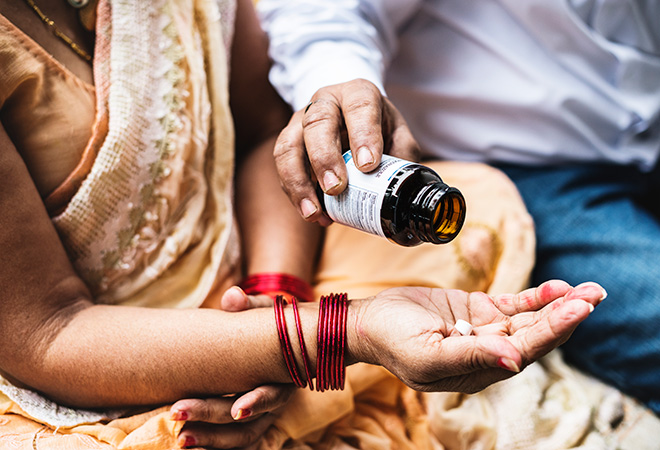
https://www.orfonline.org/expert-speak/the-indian-pharma-industry-can-do-better-than-conspiracy-theories-and-ad-hominem-attacks-52168/
In a country like India, where systems to study and document long term effects of poor quality medicines are sparse at best, addressing structural issues within our supply chain is an important debate to have.

Source: iStock/Getty Images
Katherine Eban’s recently published book “Bottle of Lies” exposing the state of affairs in the generic pharma industry has received much critical acclaim from most commentators and critics who track the Indian pharmaceutical industry. The Indian industry and its lobbyists, who have rarely been subject to such minute scrutiny by the press, has been predictably lashing out at the book. Too often in the process, they end up making personal attacks on the journalistic integrity of the author without making any attempt to engage with her substantive reporting. One such example is Ashok Madan’s recent post where he accused Eban of having a “prejudiced mind.” There are others on Twitter making even worse insinuations.
These attacks against Eban’s work is in keeping with a playbook of the Indian pharmaceutical industry to deal with its critics. This playbook includes the threat of action for defamation, actually suing critics for defamation, the ‘anti-national’ argument and lastly to claim a conspiracy theory against the Indian industry. Let me illustrate each of these tactics with an example.
In 2012, Dr. Chander Gulati, the editor of Monthly Index of Medical Specialties, was sued for criminal defamation, in Bangalore, for writing about a drug called Deanxit which was being sold in India despite being prohibited in Denmark which is the country of its origin. Since then, the safety of Deanxit has been the subject of discussion in a Parliamentary report on the CDSCO, the drug has been banned twice by the Health Ministry. Both times, bans were quashed by the Karnataka High Court, on dubious grounds. I had filed a petition last year before the Delhi High Court to get the drug removed from the Indian market and hopefully the sub-committee on DTAB will make such a recommendation soon.
In 2013, when the Ranbaxy’s plea to seven counts of criminal felony for supplying sub-standard drugs to the US market was publicly reported, some Indian hospitals and pharmacies wanted clarity on their drug supply and asked the then government whether to continue with the purchase of drugs that Ranbaxy sold in India. It is an open secret that the regulatory framework in India encourages two different standards of quality for medicines. One set of manufacturing facilities make “export” quality; made to comply with CGMP and another, a much lower standard under the purview of Schedule M of the D&C Act for consumption in India. When the flag bearer of the Indian pharma industry was copping with a plea against making Not of Standard Quality (NSQ) drugs for its export market (the USA), these healthcare facilities were acting in the best interest of their patients. The official stance of the Indian government and the pharma lobby groups was to float a conspiracy theory, which alleged that the Indian pharmaceutical industry was being targeted by the American government to protect the American industry from competition from the industry in India.
In 2014, when a group of academics in North America, including Amir Attaran at University of Ottawa published a working paper on the issue of quality of drugs sold by the same Indian companies to different countries, the Indian government threatened to sue the academics for defaming the Indian industry. As lawyer and scholar Gautam Bhatia explained at the time, such an action was legally untenable.
In 2015, when the whistle blower at GVK Bio, risked his life to expose the wrongdoings at the facility, the government and industry sold the media a story of a love story that had gone wrong.
In 2016, when I approached the Supreme Court through a PIL, the Drug Controller General of India basically insinuated that I was an “anti-national” because I sought to question the quality of Indian medicines before an Indian court. Since the court dismissed my petition saying my arguments were academic, the government of India has made bioequivalence and stability testing compulsory — I had raised both these issues in my PIL. After a second petition of mine was admitted by the Delhi High Court, two of the drugs I had targeted in the original PIL before the Supreme Court have been banned or withdrawn by the companies in question. One can judge for themselves why these manufacturers would rather withdraw profitable drugs than litigate against my petition in the Court. I had the best interests of patients in India at heart in both cases.
I am sure there are more instances of others who have spoken up against the industry being painted as anti-national and libelous by Indian pharma lobbyists and the government. At the end of the day, I think it is up to journalists and editors to separate sense from nonsense and ensure that crucial issues do not get drowned out by these personal attacks and threats of defamation. We have seen this playbook in action way too many times before, and all I can say is it is all too predictable.